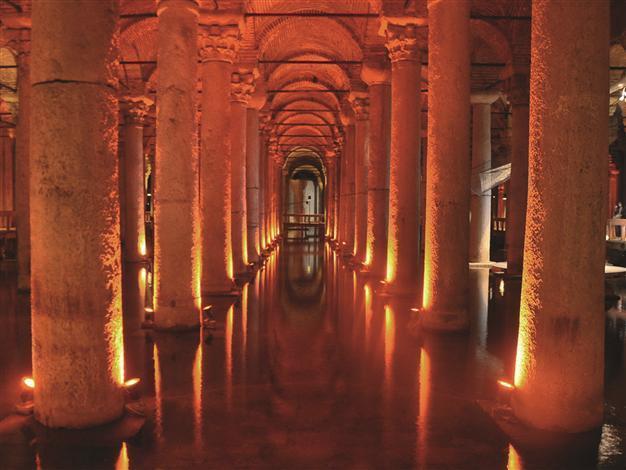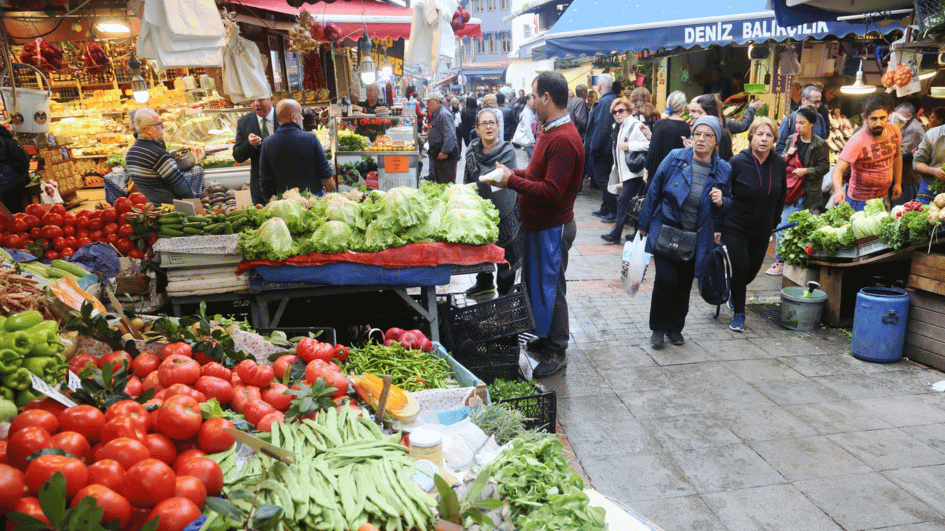Providing water to Istanbul - historically
NIKI GAMM ISTANBUL - Hürriyet Daily News

The Yerebatan or Basilica Cistern, is across the street from Hagia Sophia. It is one of the best known cisterns in Istanbul.
March 22 was World Water Day and the World Water Forum, just held in Marseille, debated the “Istanbul Pact,” which has over 1000 signatories and is committed to the principles of sustainable management of water resources. For example, some of our readers will remember the water rationing of the 1980s because drought, overuse of existing supplies and the lack of foresight had brought the situation to that point. Istanbul is fortunate enough to have the remains of the methods in which similar situations were resolved by the population of the city over the centuries.Istanbul was lucky from the beginning in having several streams and many springs, especially in the area today known as Beyoğlu. The streams ran into the Golden Horn and the Bosphorus. Some dried up while others were like the one that Sultan Ahmed III diverted in order to build his famous playground at Saadabad. Today, the streambeds have been built over and one only becomes aware of them when there’s heavy rainfall in the city.
The first structure built to protect water sources must have been what is called a tonoz (alternative spelling tonos). This is a vaulted building that covered a spring or well and was used by people in its neighborhood for water. The tonoz still exists today but it isn’t used to supply water any more. By law, any place identified as a tonoz cannot be built on.
Bigger population causes bigger water problem
As the population of Constantinople grew, the Romans and the Byzantines had to find more water sources in order to supply the city’s fountains, pools and baths. So they turned to cisterns and aqueducts.
In the old city, cisterns were built to collect rain water and probably served as the end point for water being brought to the city by aqueduct. There are several quite large cisterns still in existence from the Byzantine period. The one best known, the Yerebatan or Basilica Cistern, is across the street from Hagia Sophia. It has been measured as 140 meters long and 70 meters wide and it is estimated to have the capacity to store 100,000 tons of water from rainfall or brought by the Valens and the Maglova Aqueducts. Sources indicate that 7,000 slaves were involved in building it.
The first known aqueduct was built by the Assyrians at the beginning of the eighth century B.C. and, while the Greeks are known to have had aqueducts, it is the Romans who particularly developed the structure. They built 11 aqueducts in Rome and around 200 in the various provinces of the Roman Empire. Emperor Hadrian [reigned 118-138 A.D.] is credited with building an aqueduct that took water from the Kağıthane and Alibeyköy Streams and transferred via the aqueduct to the Old City on the historic peninsula. It has since disappeared, so few details are known about it.
Aqueduct of Valens
The most important of the cisterns built by the Romans is the one known as the Aqueduct of Valens (Bozdoğan in Turkish), amed after the emperor who completed its construction in the fourth century A.D. It stretched as far as Thrace and transported water over 250 kilometers. From the aqueduct’s end point in today’s Fatih district, water was distributed to three open reservoirs and over a hundred underground cisterns like the one described above; the aqueduct provided over one million cubic meters of water to the city. Today only 971 meters of the Valens remain, while its original height of 29 meters appears much lower today because the ground level is six meters higher than it was before.
Until the 16th century the supply of water to Istanbul was apparently adequate, but during the reign of Sultan Süleyman the Magnificent (known as Kanuni in Turkish, or “law-maker”) the famous architect, Mimar Sinan, was entrusted by the Ottoman ruler with repairing the water system and creating new aqueducts. Reportedly he fixed the water system at Topkapı Palace which had broken down and he also built what is known as the Kırkçeşme Water Supply System between 1554 and 1563. The latter consisted of four new aqueducts: Uzunkemer, Kovukkemer, Mağlova and Güzelcekemer.
One of these four aqueducts, Uzunkemer, still partially stands on the road to Kilyos, north of the city on the Black Sea. There are many springs in this area to supply the aqueduct, which is 711 meters long and 25 meters high. That the aqueduct is in good shape is probably due to the care that the Ottomans took of it, although today it is in need of repair.
Today, modern Istanbul draws on other sources of water in order to meet the needs of the millions of people who live in and around the city. The need for aqueducts and cisterns is gone, but what remains reminds one of where we came from.
















